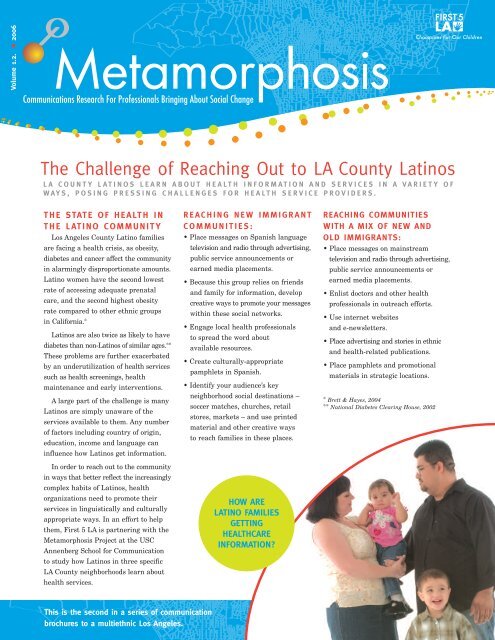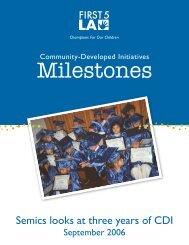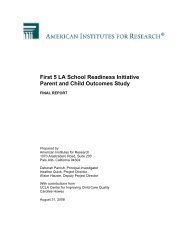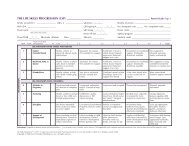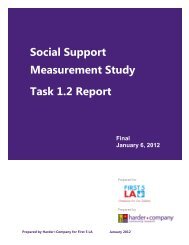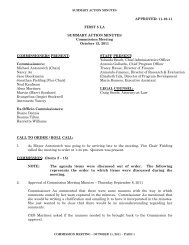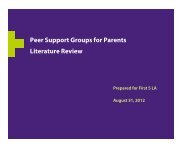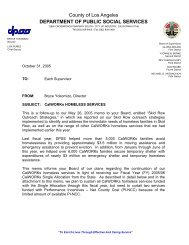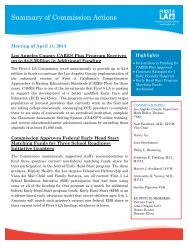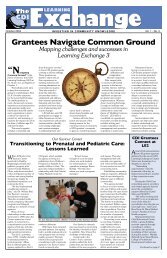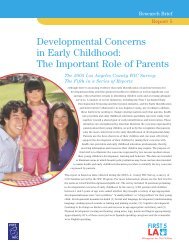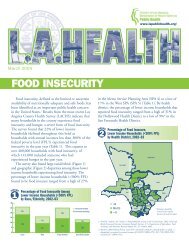The Challenge of Reaching Out to LA County Latinos - Metamorphosis
The Challenge of Reaching Out to LA County Latinos - Metamorphosis
The Challenge of Reaching Out to LA County Latinos - Metamorphosis
- No tags were found...
You also want an ePaper? Increase the reach of your titles
YUMPU automatically turns print PDFs into web optimized ePapers that Google loves.
Volume 1.2. 2006<strong>The</strong> <strong>Challenge</strong> <strong>of</strong> <strong>Reaching</strong> <strong>Out</strong> <strong>to</strong> <strong>LA</strong> <strong>County</strong> <strong>Latinos</strong><strong>LA</strong> COUNTY <strong>LA</strong>TINOS LEARN ABOUT HEALTH INFORMATION AND SERVICES IN A VARIETY OFWAYS, POSING PRESSING CHALLENGES FOR HEALTH SERVICE PROVIDERS.THE STATE OF HEALTH INTHE <strong>LA</strong>TINO COMMUNITYLos Angeles <strong>County</strong> Latino familiesare facing a health crisis, as obesity,diabetes and cancer affect the communityin alarmingly disproportionate amounts.Latino women have the second lowestrate <strong>of</strong> accessing adequate prenatalcare, and the second highest obesityrate compared <strong>to</strong> other ethnic groupsin California.*<strong>Latinos</strong> are also twice as likely <strong>to</strong> havediabetes than non-<strong>Latinos</strong> <strong>of</strong> similar ages.**<strong>The</strong>se problems are further exacerbatedby an underutilization <strong>of</strong> health servicessuch as health screenings, healthmaintenance and early interventions.A large part <strong>of</strong> the challenge is many<strong>Latinos</strong> are simply unaware <strong>of</strong> theservices available <strong>to</strong> them. Any number<strong>of</strong> fac<strong>to</strong>rs including country <strong>of</strong> origin,education, income and language caninfluence how <strong>Latinos</strong> get information.In order <strong>to</strong> reach out <strong>to</strong> the communityin ways that better reflect the increasinglycomplex habits <strong>of</strong> <strong>Latinos</strong>, healthorganizations need <strong>to</strong> promote theirservices in linguistically and culturallyappropriate ways. In an effort <strong>to</strong> helpthem, First 5 <strong>LA</strong> is partnering with the<strong>Metamorphosis</strong> Project at the USCAnnenberg School for Communication<strong>to</strong> study how <strong>Latinos</strong> in three specific<strong>LA</strong> <strong>County</strong> neighborhoods learn abouthealth services.REACHING NEW IMMIGRANTCOMMUNITIES:• Place messages on Spanish languagetelevision and radio through advertising,public service announcements orearned media placements.• Because this group relies on friendsand family for information, developcreative ways <strong>to</strong> promote your messageswithin these social networks.• Engage local health pr<strong>of</strong>essionals<strong>to</strong> spread the word aboutavailable resources.• Create culturally-appropriatepamphlets in Spanish.• Identify your audience’s keyneighborhood social destinations –soccer matches, churches, retails<strong>to</strong>res, markets – and use printedmaterial and other creative ways<strong>to</strong> reach families in these places.HOW ARE<strong>LA</strong>TINO FAMILIESGETTINGHEALTHCAREINFORMATION?REACHING COMMUNITIESWITH A MIX OF NEW ANDOLD IMMIGRANTS:• Place messages on mainstreamtelevision and radio through advertising,public service announcements orearned media placements.• Enlist doc<strong>to</strong>rs and other healthpr<strong>of</strong>essionals in outreach efforts.• Use internet websitesand e-newsletters.• Place advertising and s<strong>to</strong>ries in ethnicand health-related publications.• Place pamphlets and promotionalmaterials in strategic locations.* Brett & Hayes, 2004** National Diabetes Clearing House, 2002This is the second in a series <strong>of</strong> communicationbrochures <strong>to</strong> a multiethnic Los Angeles.
GLENDALE (N=151):DIFFERENTNEIGHBORHOODS,DIFFERENTLEARNING HABITSSurveys <strong>of</strong> Latino residents in threespecific neighborhoods in Los Angeles<strong>County</strong> illustrate how a one-size-fits-alloutreach approach is unlikely <strong>to</strong>succeed. Families in each <strong>of</strong> theseareas display strikingly differenthabits when it comes <strong>to</strong> where theygo for reliable information onhealth issues.DEMOGRAPHIC PROFILEGlendale is the third largest city (a 30.5square-mile area) in Los Angeles <strong>County</strong>.Surrounded by the San GabrielMountains, it lies eight miles northeast <strong>of</strong>Los Angeles with three major freewaystraversing the city. Glendale is an ethnicallydiverse area, with about half the 200,000residents being foreign-born. According <strong>to</strong>the 2000 Census, non-Hispanic Whiteresidents (excluding Armenians) constituteWESTSIDE35 percent <strong>of</strong> the population, while 21percent is Armenian, 20 percent is Latinoand 16 percent is Asian from differentcountries <strong>of</strong> origin. Seventy-nine percent<strong>of</strong> the Glendale residents over the age <strong>of</strong>25 have a high school diploma, nearly 40percent own homes, and the medianhousehold income is approximately $41,800.PICO UNION (N=301):from Central American countries). This area isrelatively poor – the Latino median household incomeis $19,408. Only 12 percent have a high school diploma.Relative <strong>to</strong> the other study areas and samples, PicoUnion residents are the poorest, least educated,youngest, least likely <strong>to</strong> own a home, and have thehighest usage rate <strong>of</strong> public transportation as theprimary mode <strong>of</strong> travel.DEMOGRAPHIC PROFILEPico Union is an ethnically diverse area, close <strong>to</strong> theCivic Center (1.7 miles) and also borders Korea<strong>to</strong>wn.According <strong>to</strong> the 2000 Census, almost 79 percent <strong>of</strong> thepopulation in Pico Union is Latino; <strong>of</strong> these, 69percent are first-generation immigrants (primarily
HOW DO YOU REACH THE <strong>LA</strong>TINO COMMUNITYWITH HEALTH CARE INFORMATION?GLENDALESOUTHEAST (N=438):SOUTHPASADENAKOREATOWNP ICO UNIONGREATERCRENSHAWEAST <strong>LA</strong>HUNTINGTONPARKSOUTH GATECUDAHYDEMOGRAPHIC PROFILE<strong>The</strong> southeast region includes the contiguous cities<strong>of</strong> Hunting<strong>to</strong>n Park, South Gate and Cudahy, anarea <strong>of</strong> 11.6 square miles east <strong>of</strong> the Los AngelesRiver and Los Angeles city limits. Although theseareas were his<strong>to</strong>rically white suburban communities,dramatic demographic and cultural shifts haveoccurred in the last three decades. <strong>The</strong>se areasare now Latino (mostly Mexican-origin) ethnicenclaves. According <strong>to</strong> the 2000 Census, 96 percent <strong>of</strong>the <strong>to</strong>tal population <strong>of</strong> Hunting<strong>to</strong>n Park, 92 percent<strong>of</strong> South Gate and 94 percent <strong>of</strong> Cudahy is Latino.Residents are relatively young and only 34 percenthave completed high school. <strong>The</strong> median householdincome is about $32,500 and about 22 percent livebelow the poverty line. More than half the residentsare first-generation immigrants.
WHAT ISTHE METAMORPHOSIS PROJECT?<strong>The</strong> project was born in 1992, in large part as a result<strong>of</strong> the riots that shook Los Angeles. Dr. Sandra J.Ball-Rokeach, the developer <strong>of</strong> <strong>Metamorphosis</strong>, knewthat as a communication researcher, she should havesomething <strong>to</strong> contribute <strong>to</strong> policymakers andpractitioners trying <strong>to</strong> bring about social change.<strong>The</strong> <strong>Metamorphosis</strong> Project—Transforming the Tiesthat Bind, the full name <strong>of</strong> the endeavor, was <strong>of</strong>ficiallylaunched in 1998 at the Annenberg School forCommunication, University <strong>of</strong> Southern California(USC). First 5 <strong>LA</strong> has funded <strong>Metamorphosis</strong> Projectresearch since 2002.<strong>Metamorphosis</strong> asks:• How can people build a sense <strong>of</strong> community thatcuts across lines <strong>of</strong> race and ethnicity?• How can residents come <strong>to</strong>gether <strong>to</strong> solvecommon problems?WHO AND WHAT DOES THEMETAMORPHOSIS PROJECT STUDY?<strong>The</strong> project studies ethnic areas <strong>of</strong> Los Angeles.So far research has been conducted with thefollowing groups:• African-Americans in the Greater Crenshaw area.• Anglos on the Westside and in South Pasadena.• Chinese in the Greater Monterey Park area.• Koreans in Korea<strong>to</strong>wn.• <strong>Latinos</strong> in East <strong>LA</strong>, Pico Union, and the threesoutheast cities <strong>of</strong> Hunting<strong>to</strong>n Park, South Gate,and Cudahy.• Anglos, <strong>Latinos</strong>, and Armenians in Glendale.First 5 <strong>LA</strong> is a unique child advocacy organizationcreated by California voters that invests <strong>to</strong>baccotax revenues for programs <strong>to</strong> improve the lives <strong>of</strong>children prenatal through 5 in Los Angeles <strong>County</strong>.First 5 <strong>LA</strong> champions health, education and safetyissues benefiting young children and families.First 5 <strong>LA</strong>750 Alameda Ave.Los Angeles CA, 90012www.first5la.org(213) 482-5902To learn more about this <strong>to</strong>pic and other researchbeing done by the <strong>Metamorphosis</strong> Project at USC’sAnnenberg School for Communication, visit thewebsite at www.metamorph.org.


